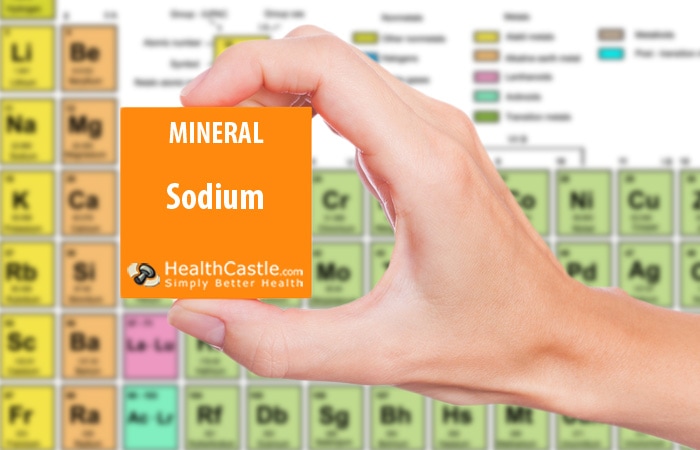
Written By: Carolyn Berry, RD
Title: Registered Dietitian
Alumni: University of British Columbia
Last Updated on:


Along with chloride, calcium, magnesium and potassium, sodium is an electrolyte. Sodium chloride (40% sodium; 60% chloride) is the chemical name for salt. One teaspoon of salt weight 5 grams and contains about 2300 mg of sodium. On average, Canadians eat about 3400 mg of sodium per day. That’s more than 1000 mg above the daily maximum.
The Dietary Reference Intakes (DRI) for sodium are shown below:
| Age Group | Recommended Dietary Allowance (RDA) per Day | Tolerable Upper Intake Level (UL) per Day |
| Adults | ||
| 19 to 50 years | 1.5 g | 2.3 g |
| 51 to 70 years | 1.3 g | 2.3 g |
| 71 years and up | 1.2 g | 2.3 g |
| Kids and Youth | ||
| 1 to 3 years | 1.0 g | 1.5 g |
| 4 to 8 years | 1.2 g | 1.9 g |
| 9 to 13 years | 1.5 g | 2.2 g |
| 14 to 18 years | 1.5 g | 2.3 g |
| Special Considerations | ||
| Pregnant women 14 years and up | 1.5 g | 2.3 g |
| Lactating women 14 years and up | 1.5 g | 2.3 g |
Sodium is the major positively charged electrolyte in the extracellular fluid. Its exchange with potassium across cell membranes allows our cells to maintain proper acid-base balance, blood pressure and fluid balance.
Sodium assists in the absorption of certain nutrients including chloride, amino acids, glucose, and water. Some nutrients cannot be passively absorbed into the cell through the cell membrane. For example, cells transport glucose via the process of active transport, which involves assistance from a sodium-potassium pump. This pump works by acting as a carrier protein that transports glucose through the cell membrane.
Sodium is also involved with the transmission of nerve signals and aids in muscle contraction. The release of sodium from inside to outside the cell stimulates the spread of nerve signals to nervous tissue and muscles. This is how muscle contraction works.
High blood pressure (also known as hypertension) is more common in people who consume high sodium diets. Whether or not high sodium diets actually cause high blood pressure is unclear and controversial. More research is needed in order to understand this better. Hypernatremia is a condition in which there is an abnormally high amount of sodium in the blood. This is not caused by eating too much sodium, but by those with congestive heart failure or kidney disease who are not able to excrete sodium from the body effectively.
Sodium deficiencies are very rare in the North American diet, as sodium is usually consumed in excess. Nevertheless, there are certain conditions that can cause dangerously low blood sodium levels, also known as hyponatremia. Hyponatremia can occur with severe diarrhea, vomiting, or excessive prolonged sweating. Active people who drink large amounts of water and do not replace sodium are also at risk for hyponatremia.
Almost 80% of the sodium we eat comes from processed and packaged foods, not the salt shaker. This includes: smoked, cured, salted or canned meat, fish or poultry including bacon, cold cuts, ham, frankfurters, sausage, sardines, caviar and anchovies, beans canned with salt, canned entrees, cheese, breads, cereals, sauces, pickled foods, commercial rice or pasta mixes and condiments. Fast foods and restaurant meals are also usually very high in sodium.
A small amount of sodium is found naturally in foods.
| Food | Sodium per serving |
| Bacon, cooked, 2 1/2 oz | 1555-1920 mg |
| Turkey bacon, 2 1/2 oz | 1714 mg |
| Ham, cured, cooked, 1 1/2 oz | 621-1125 mg |
| Soy sauce, 1 tbsp | 914-1038 mg |
| Cottage cheese (1%, 2%), 1 cup | 788-970 mg |
| Refried beans, canned, 3/4 cup | 825-987 mg |
| Luncheon/deli meat, 2 1/2 oz | 552-970 mg |
| Sauce, teriyaki, 1 tbsp | 700 mg |
| Chicken/turkey, rotisserie, 2 1/2 oz | 253-628 mg |
| Chips, all varieties, 50 g/40 chips | 262-502 mg |
| Salami or pepperoni, 2 1/2 oz | 334-418 mg |
| Chicken nuggets or burger, cooked, 2 1/2 oz | 334-418 mg |
| Bread, all types, 1 slice | 228-238 mg |
| Oatmeal, instant, cooked, 3/4 cup | 216-240 mg |
| Breakfast cereal, Corn Flakes, 3/4 cup | 200 mg |
In the United States: The Daily Value (DV) for sodium is 2400 mg for ages 4 and older. The number you see on the Nutrition Facts label is a percentage calculated by dividing the amount of sodium in one serving of the food by the daily value. For example, 1 tbsp of teriyaki sauce, which contains 700 mg, has 29% of the daily value (DV) for sodium.
In Canada: The Daily Value for sodium is also 2400 mg. Listing the DV for sodium on the label is mandatory. Health Canada says that 5%DV or less is low and 20%DV or more is high. Therefore, using the example above, 29% DV for 1 tbsp on teryaki sauce is considered to be a high amount of sodium.
Alumni: University of British Columbia – Carolyn Berry is a Vancouver-based Registered Dietitian, self-proclaimed foodie, marathon runner, and owner of Berry Nourished. Carolyn works in a variety of areas including clinical nutrition, outpatient counselling at Medisys Preventive Health Clinic, as a nutrition tour leader with Save-On-Foods, and in the media, including segments on CBC Television, CKNW and Spice Radio. Through informative and practical nutrition advice and her food-first approach to health, Carolyn fulfills her passion to empower others with knowledge about nutrition so that they can make the best decisions to improve their health. She strongly believes that food should be both healthful and delicious.
micronutrient - minerals, minerals, sodium, vitamins - minerals